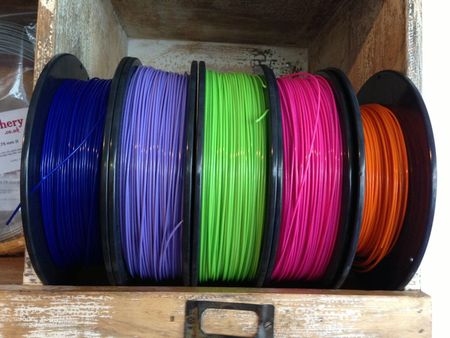Anyone who owns a personal 3D printer begins to think up features that would make their life easier. A few innovative startup companies actually have implemented some of them, but we’d love to see a personal 3D printer with all of these radically useful capabilities.
Failure Detector. The worst is to discover, the next morning, that your 12 hour print is large pile of spewed spaghetti filament. Our ideal 3D printer would detect a print fail, perhaps optically or using some other means and stop printing before wasting all that expensive filament.
Live Progress Video. How’s your print going? You don’t know unless you physically visit your printer. Why not include a camera on the print bed to enable live smartphone video access to the print action?
Alerts and Notifications. “Is my print done? The slicing software said 6.5 hours, but it’s still going!” Why don’t printers send a notification when prints complete? And when they fail, too.
Materials Verification. “Crap. I loaded PLA plastic when I should have loaded ABS.” Printers should have a means to detect the type of material in the extruder and at least warn you of impending issues.
Capacity Check. “My print stopped halfway through because I ran out of material!” Why printers don’t have a mechanism to do this is beyond us. A simple weigh scale apparatus might be able to at least in a rudimentary fashion, tell us if there’s enough filament to proceed.
Print Visualization. When selecting a model on the printer’s console, you should be able to see what it looks like. Printers should include a screen capable of displaying – and rotating models to verify that you’re printing the correct model.
Automatic Print Removal. Years ago MakerBot offered a kind of conveyer belt print bed that automatically removed prints when done. This was a spectacular feature, as it transformed your machine into a factory that could print dozens of objects repeatedly. Why can’t we have a print bed that could remove objects?
Automatic Bed Prep. It might be blue tape, hairspray, Cubify glue, kapton tape or just a simple cleaning wipe, but many personal 3D printers require the print bed to be prepped before starting the print. Why can’t this be done automatically?
Air Cleaner. Melting PLA plastic smells wonderful; melting ABS smells awful. Either way, personal 3D printers should include a fan/filter to remove these potentially dangerous odors from the printer’s vicinity.



Luckily Robox® will do all of these things…Welcome to the future of micro-manufacturing.
Luckily Robox® will do all of these things…Welcome to the future of micro-manufacturing.
Many of these are easy to do yourself. I use a Twine with a magnet sensor to send me an email when prints finish. And cheap WiFi webcams to monitor progress from anywhere… And finally have an air scrubber for ABS (http://www.thingiverse.com/thing:125264) that solves that issue. (I also designed a filament movement monitor for a previous generation of printer that I used, but which I now find redundant)
Should some of these be included in printers? Absolutely – #1 air scrubbers for safety reasons….
Many of these are easy to do yourself. I use a Twine with a magnet sensor to send me an email when prints finish. And cheap WiFi webcams to monitor progress from anywhere… And finally have an air scrubber for ABS (http://www.thingiverse.com/thing:125264) that solves that issue. (I also designed a filament movement monitor for a previous generation of printer that I used, but which I now find redundant)
Should some of these be included in printers? Absolutely – #1 air scrubbers for safety reasons….
Julia Vase #011 – Heatwave by Virtox
is licensed under the Attribution – Non-Commercial – No Derivatives license.
http://www.thingiverse.com/thing:126567
Julia Vase #011 – Heatwave by Virtox
is licensed under the Attribution – Non-Commercial – No Derivatives license.
http://www.thingiverse.com/thing:126567
The Afinia H479 software has a neat capacity feature – when you feed in a new spool it has you enter its weight, then keeps track of how many grams have been extruded.
The Afinia H479 software has a neat capacity feature – when you feed in a new spool it has you enter its weight, then keeps track of how many grams have been extruded.